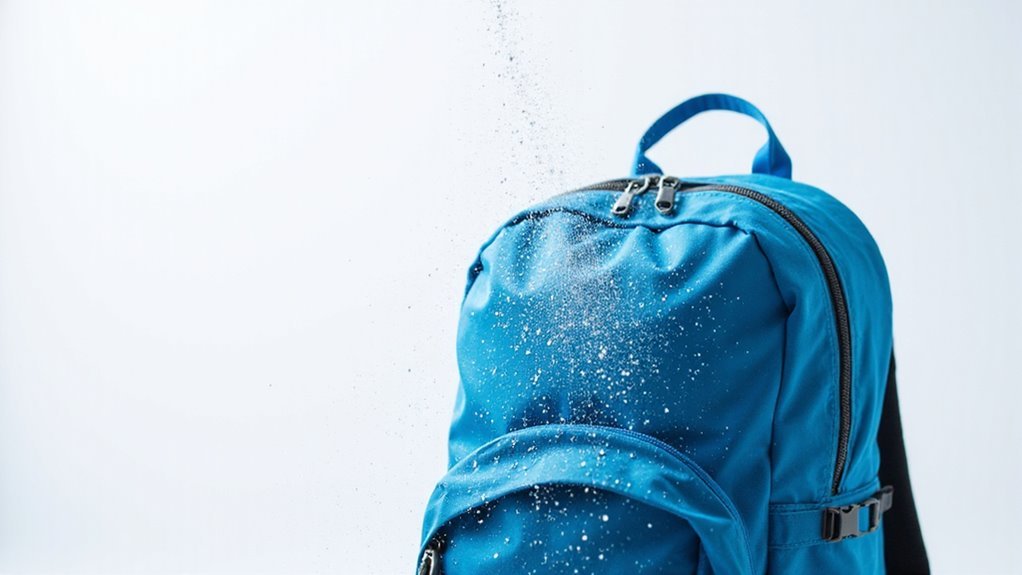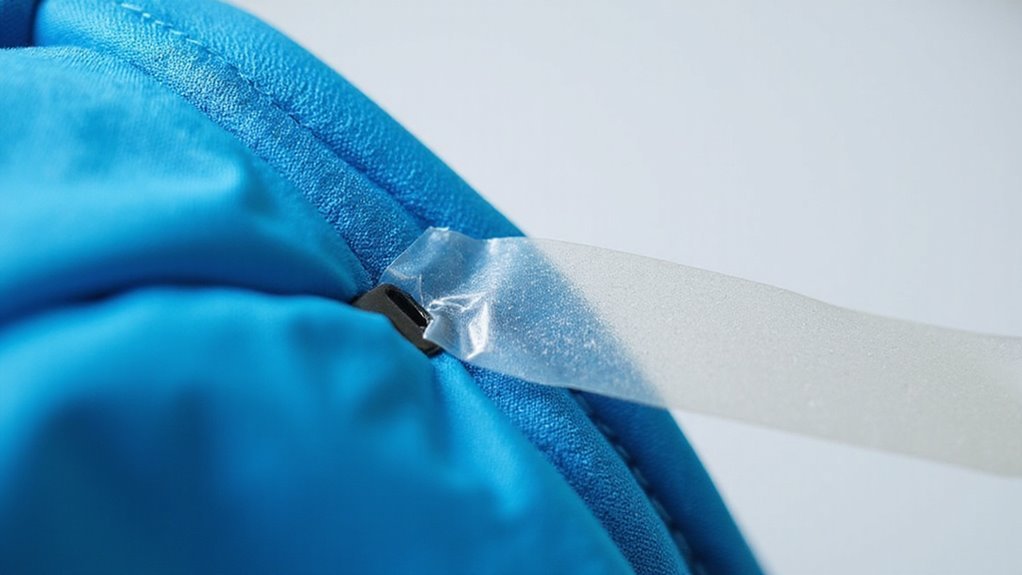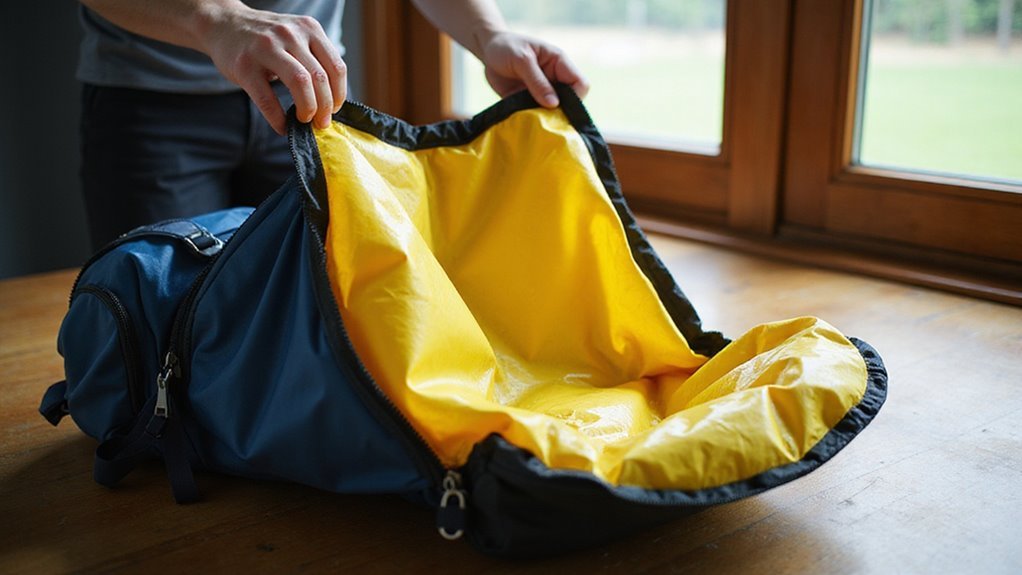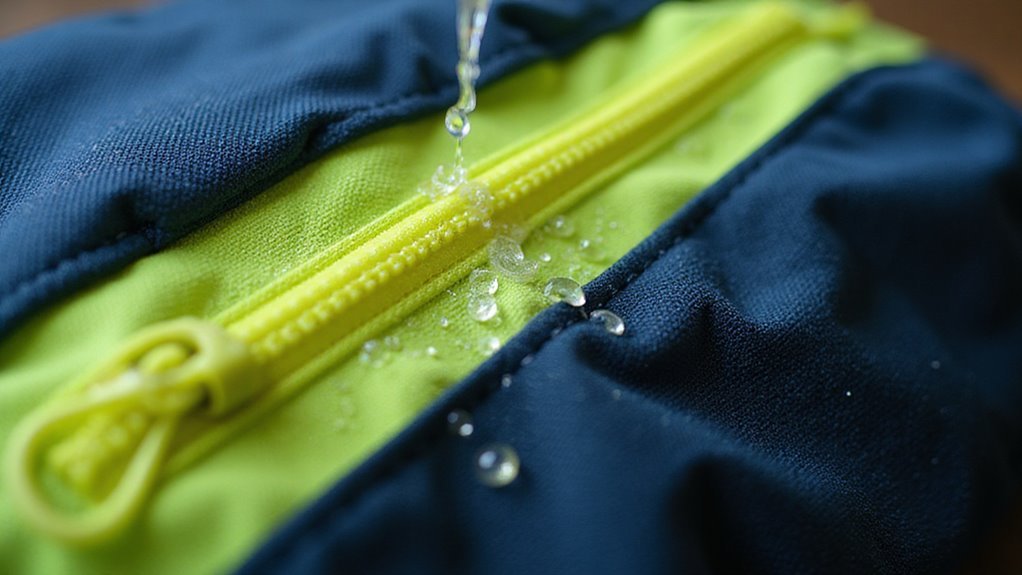Like a trusty umbrella in a monsoon, your backpack needs serious waterproofing to protect what’s inside. We’ve tested dozens of solutions across brutal conditions – from light drizzles to torrential downpours – to identify what actually works. There’s a world of difference between marketing hype and real water resistance. Let’s cut through the noise and get to the proven methods that’ll keep your gear bone-dry when it matters most.
Waterproof Sprays and DWR Treatments

A good waterproof spray or DWR treatment is your backpack’s first line of defense against the elements.
We’re talking about creating a protective barrier that makes water bead up and roll right off your outdoor gear – pretty essential stuff.
Here’s the deal: Clean the fabric first (seriously, don’t skip this).
Apply your DWR (Durable Water Repellent) treatment evenly, and you’ll boost water resistance while maintaining the performance of the fabric.
Products like Nikwax TX.Direct offer reliable water-repellent properties.
Don’t forget: You’ll need reapplication every 3-12 months.
This prevents moisture absorption and keeps your gear breathing properly. Additionally, using Durable Water Repellent treatments ensures that the fabric remains effective over time, enhancing overall longevity.
Roll-Top Dry Bag Systems
When you’re serious about keeping your gear bone-dry, roll-top dry bag systems deliver unbeatable protection.
These durable materials, featuring TPU lamination and high resistance to abrasion, create an airtight seal through their innovative roll-top closure design.
We love how these waterproof bags combine lightweight and packable construction with serious functionality.
From external attachment points to adjustable straps, they’re engineered for real-world use.
Whether you’re packing a 5-liter bag for day trips or a 50-liter beast for extended adventures, these systems guarantee your gear stays dry in the wettest conditions.
Seam Sealants and Tapes

Even the most rugged backpack remains vulnerable at its seams – that’s where seam sealants and tapes become your critical defense.
We’ll be blunt: water loves finding weak spots in your gear. High-quality seam sealants like Gear Aid Seam Grip+ create a waterproof barrier that laughs at heavy rain.
For serious waterproofing, adhesive tape reinforces those vulnerable stitched areas, dramatically boosting water resistance.
Don’t skip maintenance – harsh conditions eat away at waterproof performance over time. Regular inspection and reapplication of sealants keep your technical pack’s moisture protection rock-solid. Additionally, applying sealants periodically ensures that your gear remains ready to face unexpected weather challenges.
Trust us, you’ll thank yourself when that surprise downpour hits mid-trail.
Pack Covers and Rain Shells
Two essential layers stand between your gear and nature’s worst – pack covers and rain shells.
We’ll show you why they’re your best defense against moisture. Pack covers, crafted from waterproof materials with Durable Water Repellent finishes, slip over your backpack for instant protection.
Look for models with elastic hems and secure fit features for quick deployment. Don’t overlook those reflective elements – they’re lifesavers in low visibility. Additionally, effective protection methods like combining internal and external solutions can further enhance your gear’s resilience against the elements.
And here’s a pro tip: regularly inspect for rips or damage. Even tiny tears welcome water ingress. Trust us, you’ll want this double-layer protection when storms roll in.
Internal Waterproof Liners

Pack covers might shield the exterior, but smart hikers know true waterproofing starts from within. Internal waterproof liners create an impenetrable barrier against moisture intrusion, using durable nylon and sealed seams to keep your gear bone-dry.
We’re talking serious waterproofing solutions here – lightweight yet bombproof protection that considerably boosts your pack’s waterproof rating.
The best part? Most are removable liners, making maintenance a breeze. Trust us, when you’re caught in a downpour or your pack takes an unexpected swim, you’ll be glad you’ve got waterproof materials working from the inside out.
Wax-Based Waterproofing Methods
When durability meets old-school ingenuity, wax-based waterproofing stands as one of the most reliable methods for protecting your pack.
We’ve found that creating a water-repellent barrier on fabric surfaces requires careful application of heated wax to enhance waterproof properties.
Products like Nikwax Wax Cotton Proof and Otter Wax penetrate deep into fibers while maintaining breathable materials.
Here’s the catch: you’ll need regular reapplication every 3-6 months to maintain ideal water resistance.
Fair warning – your pack might darken slightly after treatment.
But we’ll take that trade-off any day for bombproof protection against the elements. Additionally, many waterproof backpacks, like the Mission Workshop Vandal, are designed with weatherproof compartments to enhance their durability against liquid exposure.
Silicone-Based Protection Solutions
Modern silicone-based solutions offer next-level protection without the fuss of wax treatments.
We’ll tell you why they’re revolutionary: these versatile formulas create a breathable, water-repellent shield that works on everything from nylon to leather. They’re practically foolproof to apply.
Here’s what makes them superior: they saturate fabric fibers for long-lasting moisture protection while maintaining your pack’s natural feel.
Plus, many include UV protection to prevent sun damage. You’ll need to handle reapplication every 3-12 months, depending on use, but that’s a small price for exceptional waterproofing that won’t compromise your gear’s performance.
Waterproof Compartment Organizers
Let your gear survive the elements with waterproof compartment organizers – they’re the unsung heroes of backpack organization.
These durable compartments, featuring sealed seams and waterproof materials like TPU-coated nylon and PVC, guarantee your contents remain dry in challenging conditions.
We’re talking serious protection here: roll-top closures and watertight zippers that laugh in the face of rain.
Perfect for outdoor adventures, these organizers let you sort electronics, clothes, and essentials into protected zones. Additionally, they often come equipped with organizational compartments that allow for easy access and separation of your gear.
When the adventure’s done, they fold flat for easy storage.
It’s time to upgrade your pack with this bulletproof organization system.
All-Weather Zipper Treatments

To guarantee your backpack’s zippers don’t become its weakest link, all-weather zipper treatments are your first line of defense against moisture infiltration.
We’ve found that silicone and wax-based formulations create an impenetrable barrier against water ingress, keeping your gear dry when it matters most.
Here’s the drill: clean those zippers thoroughly, apply your treatment (we recommend Gear Aid Zip Care) along the entire zipper line, and let it cure.
Don’t skip regular reapplication, especially after harsh weather exposure. Trust us – this simple step will prolong the lifespan of your waterproof zippers and maintain their waterproofness.
Professional Waterproofing Services
While DIY waterproofing gets the job done for basic needs, professional waterproofing services deliver military-grade protection that’s worth every penny. We’ve seen trained technicians transform vulnerable bags into fortresses through seam sealing and durable waterproof coatings. These waterproofing methods extend lifespan dramatically by preventing moisture damage.
| Service Type | Protection Level | Duration |
|---|---|---|
| Basic Seal | Standard | 6 months |
| Advanced Guard | Professional | 1 year |
| Ultimate Shield | Military-Grade | 2+ years |
| Custom Treatment | Material-Specific | Varies |
Let’s face it – professional waterproofing outperforms DIY every time. Their specialized treatments come with guarantees you can’t match at home.
Frequently Asked Questions
What Is the Best Waterproof Material for Backpacks?
We’ve found high-density nylon fabric with DWR coating offers maximum durability and waterproof protection, while TPU-treated materials balance weight considerations and cost efficiency, making them ideal for performance backpacks.
How Can I Make My Backpack Waterproof?
We’ll help waterproof your backpack using waterproofing sprays, seam sealing, and waterproof liners. Add silicone coatings, waterproof covers, and maintain fabric treatments regularly for maximum protection during outdoor adventures.
What Is the Best Waterproof Backpack?
With 90% of outdoor enthusiasts prioritizing waterproofing, we’d recommend the Osprey Transporter WP 30. It’s IPX6-rated, features recycled nylon construction, and balances durability with reasonable pricing at £108.49.
How Do I Keep My Backpack From Getting Wet in the Rain?
We recommend using rain covers, applying waterproof coatings, and sealing seams. Inside, add dry bags for electronics. Regular maintenance of weatherproof accessories guarantees your outdoor gear stays protected from moisture.